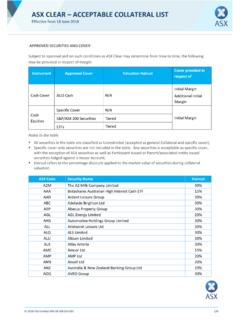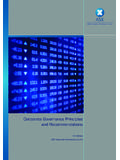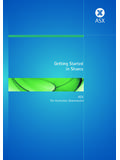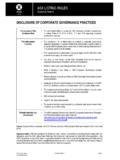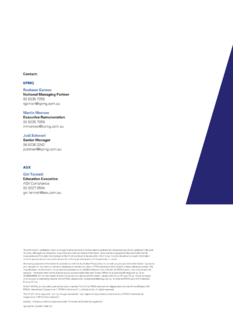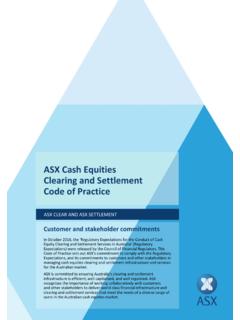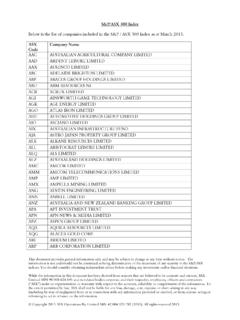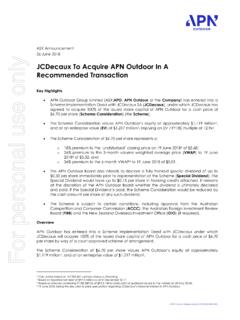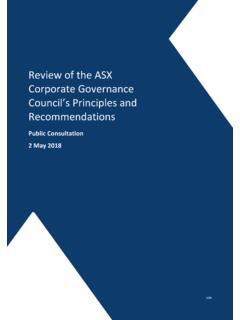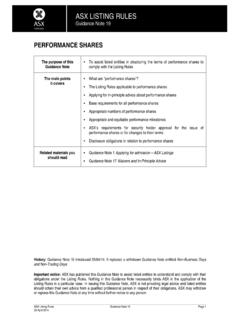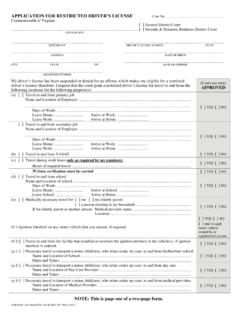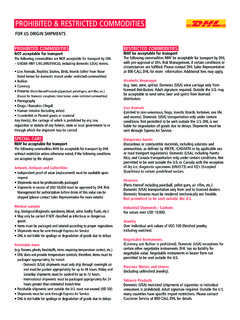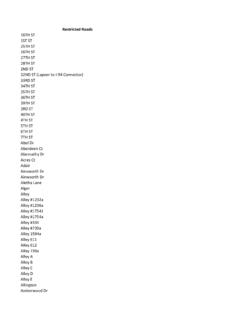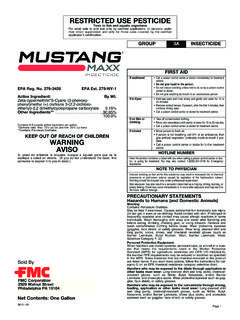Transcription of gn11 restricted securities - ASX
1 Guidance Note 11 restricted securities and Voluntary Escrow Issued: March 2002 Introduction Key topics 1. This Guidance Note is published to assist listed 1. restricted securities entities to understand how the Australian Stock 2. ASX discretion in relation Exchange Limited (ASX) Listing Rules dealing with to restricted securities restricted securities operate. Generally, the Guidance 3. Cash formula Note refers to securities issued before an entity is 4. Change of activities admitted to the official list, but similar principles 5. Transfer of restricted securities apply to securities issued by a currently listed entity. 6. Relief for charitable donations 2. restricted securities are placed in escrow for a 7. Disclosure requirements specified period (the escrow period). This prevents 8. Voluntary escrow the transfer of effective ownership or control of 9. Promoters them. Escrow is to protect the integrity of the market ASX conducts.
2 For example, escrow delays Listing Rules the time in which a vendor can realise the value of 1. Listing rule condition 7 the securities . The delay allows the value of assets or 2. Listing rule services sold to an entity to become more apparent, 3. Listing rule and for the market price of the entity's securities to 4. Listing rule adjust before the vendor receives full consideration. 5. Listing rule In that way, the business risk is shared between the 6. Listing rule 7. Chapter 9 Listing Rules vendor and other investors. 8. Appendix 9A Listing Rules 9. Appendix 9B Listing Rules The Listing Rules Cross-reference 3. Chapter 9 of the Listing Rules deals with restricted 1. Chapter 1 Listing Rules 2. Chapter 2 Listing Rules securities . There are also requirements in listing rule 3. Chapter 11 Listing Rules which must be included in an entity's 4. Appendix 1A Listing Rules constitution. 5. Guidance Note 12 - Changes to Activities Guidance Note History Re-issued: 1/7/2000.
3 December 2000. March 2002. March 2002 GN 11 Page 1. Guidance Note 11. restricted securities and Voluntary Escrow 4. restricted securities are defined in listing rule which states: (a) + securities issued in the circumstances set out in Appendix 9B. (b) + securities that, in ASX's opinion, should be treated as restricted securities . Appendix 9B. 5. Appendix 9B sets out in tabular form the categories of restricted securities , including securities issued to seed capitalists, vendors of classified assets, promoters, professionals and consultants and persons under an employee incentive scheme. It also sets out whether the securities are restricted and for how long. 6. In addition, listing rule says that unless ASX decides otherwise, restrictions do not apply to securities issued by the following entities before admission. An entity that is admitted under the profit test in listing rule An entity that has a track record of profitability or revenue acceptable to ASX.
4 An entity that, in the opinion of ASX, has a substantial proportion of its assets as tangible assets or assets with a readily ascertainable value. Entities should give ASX all relevant material at the earliest opportunity to enable ASX to determine whether restrictions will apply in each case. Discretion to treat securities as restricted securities 7. Paragraph (b) of the definition of restricted securities ' refers to securities that, in ASX's opinion, should be treated as restricted securities . Whether securities are treated as restricted securities is decided on a case by case basis. An example of a situation where ASX may exercise its discretion is where there is a change of activities attracting a requirement to comply with Chapters 1 and 2 of the Listing Rules. This is discussed further at paragraphs 17 to 20. Entities are encouraged to consult ASX about whether ASX will exercise its discretion to treat securities as restricted securities .
5 Method of restriction 8. An entity must do one of the following in respect of restricted securities , refer listing rules and Issue certificates in respect of the securities . The certificates must be placed with a bank or with a recognised trustee, who must undertake to ASX not to release the certificates without ASX's consent. Enter the securities on the issuer sponsored subregister. The entity must obtain an undertaking from its registry to apply a holding lock to the securities to prevent any movement of the securities from the holding, and not remove the holding lock without ASX's consent, refer listing rule GN 11 - Page 2 March 2002. Guidance Note 11. restricted securities and Voluntary Escrow 9. ASX will usually only consent to the release of certificates or a holding lock after completion of the escrow period. However, in exceptional circumstances, ASX may consent earlier. One such circumstance is if the restricted securities form part of a deceased estate and the beneficiary enters into a restriction agreement for the balance of the escrow period.
6 Cash formula 10. Generally, ASX has regard to cash paid for securities when deciding if the securities (or some of them) should be subject to escrow. For example, securities issued to seed capitalists are often issued for less than the issue price paid by subscribers in the initial public offering (IPO). In that case, the proportion of securities issued to the seed capitalist which is likely to be treated as restricted securities is decided by a cash formula', as defined in the Listing Rules. The cash formula is: In the case of +ordinary securities , N = (CP / IPO) x E. N= the number of shares or units not subject to escrow. CP = the total cash paid for the +ordinary securities that would otherwise be subject to escrow, divided by the number of + securities issued to the +person. IPO = the price paid in any initial public offering at the time the entity applies for admission, or if there is no public offering, the price agreed by ASX.
7 E= the number of +ordinary securities that would otherwise be subject to escrow. In the case of options which have the same terms as options offered with +ordinary securities under any IPO at the time the entity applies for admission, O= NxF. O= the number of options not subject to escrow. N= the number of shares or units not subject to escrow. F= the number of options per +ordinary security offered under the IPO. March 2002 GN 11 Page 3. Guidance Note 11. restricted securities and Voluntary Escrow Ordinary securities example 11. If a seed capitalist paid $4,000 for 10,000 shares and the IPO price of the same class of shares was $1, N = (4,000/10,000) x 10,000 = 4,000. Therefore, 4,000. shares would not be restricted securities . 6,000 shares would be treated as restricted securities . If the proceeds of the issue resulted directly in the entity holding net tangible assets that have a readily ascertainable market value, ASX may treat more, or fewer, securities as restricted securities depending on whether the market value was lower or higher than the amount of cash subscribed.
8 If no market value can be demonstrated to ASX's satisfaction, all the securities may be treated as restricted securities . Options example 12. Using the example in paragraph 10, if in addition to the 10,000 shares the seed capitalist received 10,000 free attaching options and under the IPO subscribers received one free attaching option for each share subscribed, the following would apply: O = 4,000 x 1 = 4,000. Therefore, 4,000 options would not be restricted securities and 6,000 options would be treated as restricted securities . restricted securities issued in satisfaction of debts 13. ASX will usually apply the cash formula to equity securities issued in satisfaction of a debt (that is debt for funds advanced, not debt for services) incurred before listing. The funds must not yet have been utilised by the entity or, if they have been utilised, they must still be represented by net tangible assets of a readily ascertainable market value.
9 Other matters Additional disclosures 14. At the time of listing, ASX may require additional information from an entity with restricted securities . For example in the case of a holder of restricted securities who has sold classified assets into an entity, the information required by paragraphs 53. to 61 of Appendix 1A. ASX may require pre-quotation disclosure of that information to the market. Voting and dividends of restricted securities 15. ASX does not impose any special restrictions on the voting of restricted securities which carry a vote, or on dividends or distributions, unless the restriction agreement is breached. In that case, the restriction agreement and the Listing Rules require that the securities cease to be entitled to a vote and to dividends or distributions, refer listing rules and and clause 11 of Appendix 9A. GN 11 - Page 4 March 2002. Guidance Note 11. restricted securities and Voluntary Escrow securities issued to an underwriter or sub-underwriter 16.
10 restricted securities include securities issued to a promoter, refer Appendix 9B, clause 7. A promoter includes a person who provides a service to an entity in relation to the promotion, listing or IPO of an entity, refer paragraph 38. This will include an underwriter and sub-underwriter. Change of activities 17. Listing rule provides that where an entity proposes to make a significant change to the nature or scale of its activities, if ASX requires, it must either hold a meeting of security holders to approve the change, or hold a security holders'. meeting and meet the requirements in chapters 1 and 2 as if the entity were applying for admission to the official list. This is discussed further in Guidance Note 12 - Changes to Activities: Listing Rules , and 18. Where ASX requires that a security holders' meeting be held, but does not require compliance with Chapters 1 and 2 of the Listing Rules, clauses 5 and 6 of Appendix 9B may apply.
